Findings from the Field -
My Ninth Visit to China based on data collected between 22 April and 2 May 1999 in Wuhan,
Jiangyong Prefecture.
Things learned on this trip ...
(1.) Yang Huanyi is in good
health.
(2.) He Yanxin has completed a character list.
(3.) He Yanxin wrote a new song for me.
(4.) I learned He Jinghua knows a good deal of
characters.
(5.) San chao shu and Jie jiao shu were found.
(1.) Allow me to introduce Yang Huanyi.
I have been visiting her regularly since 1993 and have learned some interesting facts.
 Ms. Yang was born in 1909 in
Yangjia village of Shang jiang xu zhen, thus making her ninety years old. At fourteen she
encountered in the same town one Yi Zaozao of Xing-fu village who was very adept at nushu
and began to learn from her. According to Ms. Yang, Xi Zaozao had bound feet and was
barely able to move about, but managed to make a living through making use of nushu on
other people's behalf. (Through several people I learned of a story involving Yi Zaozao
and a trial at court. After Yi's husband died she feared her in-laws were threatening to
seize her home. A woman claimed that her father was visited by Yi for legal assistance
because he could read Chinese characters. The consultation was rendered into nushu and she
kept it in the hem of her blouse when she entered the courtroom. She read aloud from the
nushu. Another woman contends that Yi was bringing suit and read from a document which was
rejected because the county official was unable to read it. The official's wife knew that
the document was written in nushu and it was thus confiscated. Although there are some
disparities in the two women's accounts, they both relate a rare occurrence of nushu being
used in legal proceedings.)
Ms. Yang was born in 1909 in
Yangjia village of Shang jiang xu zhen, thus making her ninety years old. At fourteen she
encountered in the same town one Yi Zaozao of Xing-fu village who was very adept at nushu
and began to learn from her. According to Ms. Yang, Xi Zaozao had bound feet and was
barely able to move about, but managed to make a living through making use of nushu on
other people's behalf. (Through several people I learned of a story involving Yi Zaozao
and a trial at court. After Yi's husband died she feared her in-laws were threatening to
seize her home. A woman claimed that her father was visited by Yi for legal assistance
because he could read Chinese characters. The consultation was rendered into nushu and she
kept it in the hem of her blouse when she entered the courtroom. She read aloud from the
nushu. Another woman contends that Yi was bringing suit and read from a document which was
rejected because the county official was unable to read it. The official's wife knew that
the document was written in nushu and it was thus confiscated. Although there are some
disparities in the two women's accounts, they both relate a rare occurrence of nushu being
used in legal proceedings.)
Ms. Yang learned nushu from Yi Zaozao about once
every week to ten days. For one strip of written nushu characters she paid 400 wen, money
that she earned from gleaning peanuts in the fields.
She learned from watching the movement of her
teacher's hand. She would practice upon returning home, using song as a means of
committing each character to memory. It took her a year to learn. She had a younger sister
who preferred leisurely pursuits to learning such tortuous things as nushu and
consequently never did learn. Only Ms. Yang and one other woman about Ms. Yang's age
bothered to learn in the village.
Once she mastered nushu she was able to write
letters to her sworn sisters as well as prayers for her local temple. She also wrote on
behalf of others. She did not require payment for writing ordinary letters, but in the
case of sanchaoshu she would get as much as 100 to 300 wen. In such an instance Ms. Yang
would write a song based on whatever omen, good or bad, she had divined from the home
situation of whomever had made the request.
After marriage her life became busy and she had no
opportunity to write nushu any longer. At first she lived in a new village of her old
town, but in two years her husband died from a poisonous snake bite. Later she remarried
into the He family at He Yuan village. Only three of the eight children she had from that
marriage survive today. Her husband was an avid gambler and ran up a great debt which was
responsible for six months of hunger out of the year. With difficulty she managed to raise
two sons. Her husband is no longer living, but on Tong-shan-ling Farm both her sons take
turns making certain their mother is living comfortably and happily.
Around 1990 a scholar from Beijing visited Ms.
Yang and urged her to rekindle her old practice of writing nushu. Ms. Yang told me that
around noontime she is often helping one of her sons with chores, but finds time now and
then to enjoy writing nushu. (This account is also written up in my interviews of 1993 and
1994 that appear in Women's Script in China, Sanichi Shohou, 1996.) In 1995 Ms. Yang was
invited to attend the Women's Conference in Beijing. (My group - the Endo group - held a
workshop there on the subject of problems involving Asian women and literacy. Ms. Yang was
there and introduced nushu to those in attendance.) She said that Beijing was an
incredible city. Tian An Men Square, too, was incredible - and "we" (Ms. Yang
and her attendants) saw the body of Mao Zedong at the Memorial Hall. Mao, she would tell
me, being China's "emperor" - was at the top. And she added the food was
beautiful and tasty, too.
In 1996 and 1997 when I visited her, Ms. Yang
wrote out a song in nushu she sang in a cheerful healthy voice.
In 1998 I conducted a survey in Beijing. I
requested He Yanxin and one other person who knew old songs quite well come up from the
countryside to Beijing for some fact-finding. This was done because local governments tend
to complicate things in the extreme - and a Chinese assistant advised me that having
informants come to Bejing might be a good idea.
At that time I had Pu Nianxian, who was to come to
Beijing, check up on Ms. Yang before leaving. Pu Nianxian saw Ms. Yang at her son's
Tong-shan-ling Farm. She reported that the youngest son had died and her condition had
weakened and her hand so shaky after the tragedy that she could not write any longer. She
had also become senile, I was told. Well, old age comes when it comes - inevitable thing
that it is - and I was compelled to resign myself to the circumstances.
I thought certainly when visiting Ms. Yang at her
son's home at Tong-shan-ling Farm this 24 April that I'd be forcing things unreasonably by
requesting she do some writing for me. I therefore brought neither pen nor paper when I
called. As I approached the son's home I saw a familiar soul walking toward the hills. As
I caught up the woman smiled at me. She was fit and fully aware of her world - hardly what
I'd consider senile. I was elated.
What follows is a summary of the interview I had
with her:
In December 1997 when her youngest son died, she
was despondent and unable to do much of anything. He had choked on something and was
unable to breathe; when he lay down he was dead.
Then in December of last year she fell and hurt
her hip. That meant two months in bed. Now she is up and walking daily, though she hasn't
a lot to do except eat and sleep because her daughter-in-law does everything for her.
There's no real need to do anything, though when she does move about she suffers from
shortness of breath and severe heart palpitations.
Since her son's death she hasn't gotten around to
writing nushu. (She did show me a red cotton cloth with nushu written on it. It was
something she'd written just before her son died and since then she hadn't felt much like
writing anything more.)
But if I wanted her to write something, she said
she'd do it.
On 26 April I went back to Tong-shan-ling Farm to
get what she'd written for me and to make a video of her as she wrote and sang.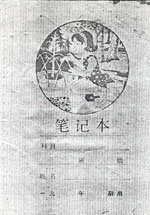
She showed me what she'd written the day before in
a small notebook (12cm X 17cm). The characters were
boldly written and showed no indication of having been executed by a shaking hand. She
told me it was a song of friendship and bonding among sisters.
For the purpose of making the video I asked for
more writing examples on new paper. Various types of paper were presented though they made
for difficult writing as they had no lines - nor were the thicknesses of ball point and
marking pens to my liking. After trying this and that I settled for ball point pen on what
was left of the notebook paper from the day before.
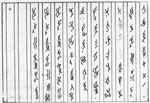
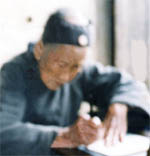 She held the pen between her thumb and middle finger with her index finger
over it in the manner of writing with a calligraphic brush on rolled letter paper. Without
uttering a sound she'd write on the single page of notebook paper. Her hand did shake, but
the writing didn't show it. (See note 2.)
She held the pen between her thumb and middle finger with her index finger
over it in the manner of writing with a calligraphic brush on rolled letter paper. Without
uttering a sound she'd write on the single page of notebook paper. Her hand did shake, but
the writing didn't show it. (See note 2.)
Then she sang as she viewed her finished work. Her
voice was as clear and strong as it was the first time I heard it in 1993.
It was the song of an 18-year-old bride. The words
expressed the loveliness of silver and gold attire held by an obi with an embroidered lion
in front and silken scroll in the back.
The following is my interview with Ms. Yang.
Why did you write this song?
Well, because I like it.
What do you like about it?
This young woman marries a man she loves. He goes
into town and becomes a local official. Local officials become rich, so he returns with a
lot of money. On the way he teases a young woman on the roadside who he fails to notice is
his wife. The woman sees this as something so shameful that she kills herself. The young
bride is pitiful. I understand such a sentiment. That's why I like the song.
You don't make songs by yourself anymore?
Those songs I made I gave away. Mine was one sad
life.
Did you make any mournful bridal songs in the past
that were sung by weeping brides?
Yes, I did. But after the Liberation those kinds
of sad songs were no longer acceptable so I didn't write them anymore. What I wrote
yesterday was a song of friendship and bonding among sisters.
How many?
Four. And I liked each of them equally. There were
two others from Taiwan but they stopped coming and I miss them. They have a lot of what I
wrote. Another was about for a half year but doesn't come around anymore. Very much
missed. In December Zhao Liming came by. It seems Ms. Yang's feet were hurting her and she
came by to see me immediately. A very compassionate person.
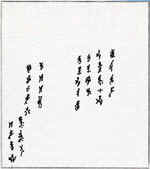 They still hurt you?
They still hurt you?
My knee joints go bad on cloudy or rainy days.
I then had her write some more on a special square
of cardboard prepared especially for poetry and autographs. (See note 3) The meaning is: "Professor Endo, whose
visits are frequent, brings to me her utmost filial righteousness."
I was pleased that she remembered the name 'Endo'
and wrote it correctly without anyone telling her how.
(2.) He Yanxin's script
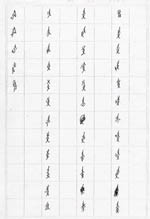
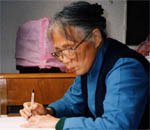 Ms. He has been working since
August 1994 on recalling the nushu she learned in her youth and is currently writing her
memoirs in nushu. In 1997 she came to Japan to give the first public demonstration of
living nushu. After that, however, her husband succumbed to a long illness and she became
immersed in farm work. She no longer has much time or energy for nushu as she has to
shoulder the responsibilities alone of raising her high school age son and junior high
school age daughter.
Ms. He has been working since
August 1994 on recalling the nushu she learned in her youth and is currently writing her
memoirs in nushu. In 1997 she came to Japan to give the first public demonstration of
living nushu. After that, however, her husband succumbed to a long illness and she became
immersed in farm work. She no longer has much time or energy for nushu as she has to
shoulder the responsibilities alone of raising her high school age son and junior high
school age daughter.
She is probably the last one able to pass on this
tradition and, as such, it is desirable to have a comprehensive compilation made of her
characters. So far since last year I have been doing just that with all of her various
works of calligraphy, letters and autobiographical materials. I asked her to write
corrections by hand of different characters taken from that body of work. (See note 4) Joint researcher Huang Xuezhen of the
Institute of Chinese Social Sciences has prepared a record of these phonemes. These will
provide a key list reference of the respective phonetic structure of each character and
the manner in which each character is used.
(3.) He Yanxin's new work
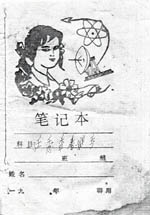 In addition, after my request that she write something
about her recent thoughts in nushu, He Yanxin has produced for me something new. (See note
5-a, 5-b) It has
the same dimensions as that written for me by Ms. Yang (12cm x 71cm) small notebook
paper), but is 9 pages with 104 lines making a total of 728 characters in the poem.
In addition, after my request that she write something
about her recent thoughts in nushu, He Yanxin has produced for me something new. (See note
5-a, 5-b) It has
the same dimensions as that written for me by Ms. Yang (12cm x 71cm) small notebook
paper), but is 9 pages with 104 lines making a total of 728 characters in the poem.
Its contents are based on the following
experience:
I went to the Nushu Symposium in Japan in the fall
of 1997. The audience was so enthusiastic but I felt embarrassed and was unable to raise
my head. There was tasty exotic food to be sampled for the first time. In the city the
neon shone to the core of my soul - and among the towering buildings I felt I was a
dragonfly swimming in the sea. The cars crawled along like lines of ants and the
Shinkansen took her to Osaka before she knew it.
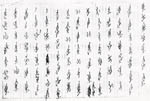 After this engaging journey I returned home to a scornful husband who
thought it selfish of me to hoard the happy times while he waited, writhing in the agony
of his illness. "Now you can witness my death!" And that is exactly what I did
the next day.
After this engaging journey I returned home to a scornful husband who
thought it selfish of me to hoard the happy times while he waited, writhing in the agony
of his illness. "Now you can witness my death!" And that is exactly what I did
the next day.
And the truly mournful days of mother and children
then began with the home empty of husband and father - no one about with whom to discuss
even the slightest matters.
Heading forward there is no great tree for
protection nor faithful mountain standing behind. Children cannot study even when they
want to and there is no money. But our son has entered vocational school at last and I saw
him off as far as the county seat. He said in his gentle words he would be a serious
student so I should just worry about my own health. I could not stop the tears when I
heard him say this.
The poem's poignancy strikes at the heart.
Thus far she has written about 20,000 characters
for me. Of those about 500 different ones have been isolated, but in this work several
characters were found not contained in that group. A continuing pursuit of her characters
is still needed.
(4.) The characters of He Jinghua
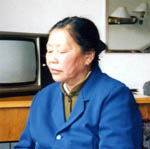 He Jinghua started writing
after the spring of 1997. As a young woman she would practice nushu over and over again by
tracing the lyrics to songs on thin sheets of paper. During field work conducted in the
summer of 1998 she told me that although she knows how to write the characters, there are
no songs she has herself written in nushu.
He Jinghua started writing
after the spring of 1997. As a young woman she would practice nushu over and over again by
tracing the lyrics to songs on thin sheets of paper. During field work conducted in the
summer of 1998 she told me that although she knows how to write the characters, there are
no songs she has herself written in nushu.
This manner of learning nushu is unique among
those who have mastered it. Typically a young woman would learn over time from
sisters-in-law, her mother or grandmother or someone who was good at it. After mastering
nushu she would then improvise lyrics in nushu for set melodies.
But Jinghua did nushu as a hobby, looking at the
shapes of the characters and then learning them. At 14, however, Jinghua entered
elementary school and learned Chinese characters. That was in the period when, even in
villages, things old were condemned as remnants of the Chinese feudal way of thinking and
there was no writing of nushu.
At the end of 1980 the word went out that in this
region there were characters for women only and a television crew introduced nushu to the
world. Jinghua saw the program and knew that those "mosquito leg" characters she
had learned as a young woman were known as "nushu." As she watched she wished
she could write with the same feeling as those adept calligraphers of that time, Gao
Yingxian and Yi Nianhua, who were featured on the show.
In 1990 she heard that Yi Nianhua had died and
realized she'd never be ab to have this woman has a teacher. It was a lonely feeling.
During the Women's Conference of 1995 a television
program marking the event featured Jinghua in an introduction to the local culture. In the
program a formal village "song place" (where in the past young women would
congregate for three days of singing as part of a wedding ritual). She sang songs such as
that of the weeping bride. She was asked at that time by Zhao Liming if she could write
nushu. She knew she could write about 200, but answered she couldn't as she feared if
asked to write them on the spot it would have looked bad in the event she couldn't do it.
After that she learned from Pu Nianxian that some
Japanese were coming to do research about nushu. By all means, she thought, she wanted to
be introduced to them. In September 1997 Pu was staying at a government-run hotel facility
and took Jinghua to where the Japanese researchers were. She saw He Yanxin writing and
thought she saw her make a mistake. She was asked by the researchers if she could write
nushu and her answer was no.
After the Endo group returned to Japan, Jinghua
started practicing nushu by looking at those examples that had been left behind. Pu
Dongwan, a former junior high school teacher who cooperated with our group as an informant
on local dialect, suggested if she were to start learning nushu she should learn from
government publication called the prefectural profile. (Note: Jiangyong Prefecture's
prefectural profile includes data on topography, climate, population, industry, education
and various other types of vital local statistics. As an item deserving special mention
nushu takes up 45 pages of the book. A list of characters is included but is extremely
slipshod and doesn't really reflect what nushu is 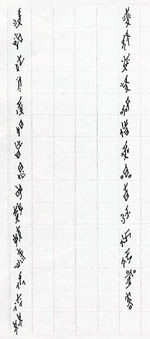 about. The profile was
published in 1995.)
about. The profile was
published in 1995.)
The prefectural profile juxtaposes nushu next to
Chinese characters in order to explain the meanings. Whatever word the user wants must be
found by first looking for the corresponding Chinese characters. The nushu are found next
to the standard Chinese and are presented such that it is possible to link the nushu
characters into a song. In Yi Nianhua's sad song it is possible to express the sad
feelings about any dead son by replacing her lyrics with others. The sounds are compatible
with the local dialect, so it is possible to sing out loud. Jinghua made one such song and
took it to Zhou Shuoyi for guidance. [Mention of this also appears in Kotoba, No. 19,
Gendal Nihongo Kenkyukai, 1998]
Thus I was able to understand the process of
Jinghua's restoration and learning of nushu letters. A portion of her list appears here. (See note 5) The quanitity does not grasp the entirety,
but Jinghua knows more than He Yanxin. Jinghua uses the list for practice and, unlike
Yanxin, has the time to practice as well. Her example demonstrates the act of nushu
restoration through learning.
(5.) Several Examples of San-chao shu
I also went to gather original materials. With the
cooperation of Huaqiao University Japanese language teachers and students I attempted to
go from village to village to get materials.
The students who went to Xia-wan Village of
Shang-jiang Xu-zhen visited the Hu family. Hu Meiyue is Gao Yinxian's granddaughter. She
learned to write from people in the village. She sang and wrote for us. (Note 7-a,
7-b, 8-a,
8-b: I also
visited her in '97. I noticed her skill in nushu was mainly an imitation of her
grandmother's without the experience of her grandmother's years.) The students purchased 2
books of her San-chao shu at 100 yuan per copy. They are clearly recent examples and are
obviously Hu's work. A villager learned that researchers were gathering examples of nushu
and created these forged samples.
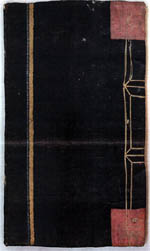
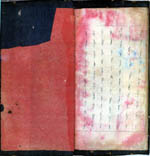
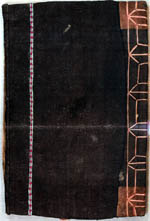
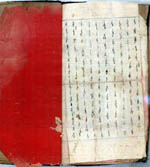
One day He Jinghua told me a man who was fortune
telling on the street corner wanted to sell some examples of San-chao shu.
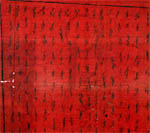 The man showed me two copies of old San-chao shu. (See note 9) Both copies had long been in the possession of
his grandmother, a person from Tang-mei Village.
The man showed me two copies of old San-chao shu. (See note 9) Both copies had long been in the possession of
his grandmother, a person from Tang-mei Village.
In addition to the San-chao shu, he showed a red
piece of paper with nushu written on it. Local word had it that it was Jie-jiao shu (a
written pledge between newlywed young girls and their sworn sisters. Red paper was used
because red is the celebratory color suited for felicitation.
According to He Zengshan the paper belonged to his
late wife whose mother's brother's wife's someone-or-other wrote on it sometime in the
second decade of the Republic. That makes it about 70 years old.
That wraps up an outline of my field work for
April. Next time I plan to use the video material I compiled to compare the respective
stroke orders in the calligraphy of Yang, He Yanxin and He Jinghua. I also plan to
complete the list of He Yanxin's characters.
Copyright©
1999, 2000, 2001 Orie Endo.

 Ms. Yang was born in 1909 in
Yangjia village of Shang jiang xu zhen, thus making her ninety years old. At fourteen she
encountered in the same town one Yi Zaozao of Xing-fu village who was very adept at nushu
and began to learn from her. According to Ms. Yang, Xi Zaozao had bound feet and was
barely able to move about, but managed to make a living through making use of nushu on
other people's behalf. (Through several people I learned of a story involving Yi Zaozao
and a trial at court. After Yi's husband died she feared her in-laws were threatening to
seize her home. A woman claimed that her father was visited by Yi for legal assistance
because he could read Chinese characters. The consultation was rendered into nushu and she
kept it in the hem of her blouse when she entered the courtroom. She read aloud from the
nushu. Another woman contends that Yi was bringing suit and read from a document which was
rejected because the county official was unable to read it. The official's wife knew that
the document was written in nushu and it was thus confiscated. Although there are some
disparities in the two women's accounts, they both relate a rare occurrence of nushu being
used in legal proceedings.)
Ms. Yang was born in 1909 in
Yangjia village of Shang jiang xu zhen, thus making her ninety years old. At fourteen she
encountered in the same town one Yi Zaozao of Xing-fu village who was very adept at nushu
and began to learn from her. According to Ms. Yang, Xi Zaozao had bound feet and was
barely able to move about, but managed to make a living through making use of nushu on
other people's behalf. (Through several people I learned of a story involving Yi Zaozao
and a trial at court. After Yi's husband died she feared her in-laws were threatening to
seize her home. A woman claimed that her father was visited by Yi for legal assistance
because he could read Chinese characters. The consultation was rendered into nushu and she
kept it in the hem of her blouse when she entered the courtroom. She read aloud from the
nushu. Another woman contends that Yi was bringing suit and read from a document which was
rejected because the county official was unable to read it. The official's wife knew that
the document was written in nushu and it was thus confiscated. Although there are some
disparities in the two women's accounts, they both relate a rare occurrence of nushu being
used in legal proceedings.)




 Ms. He
Ms. He

 He Jinghua
He Jinghua




